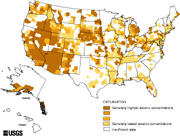Homeowners with wells are less likely to know if their water is tainted with high arsenic levels, says Alan Welch, a co-author on the USGS report released in May. Residents living in rural areas of Michigan, Wisconsin, the upper Midwest and also Minnesota, the Dakotas and southeast Oregon may all be surprised to find their counties marked dark brown on the map. Understanding the geochemical conditions that mobilize arsenic may help explain its presence:

Click here for a larger image.
